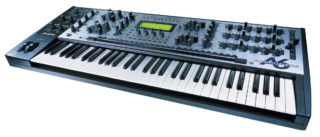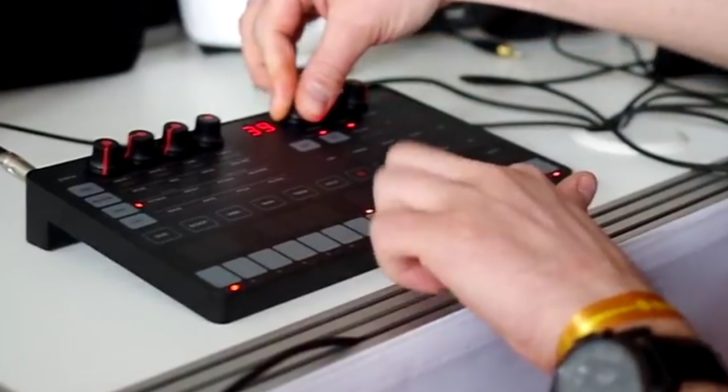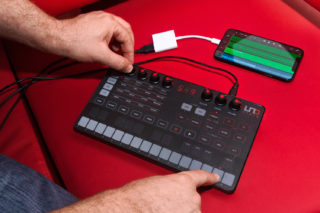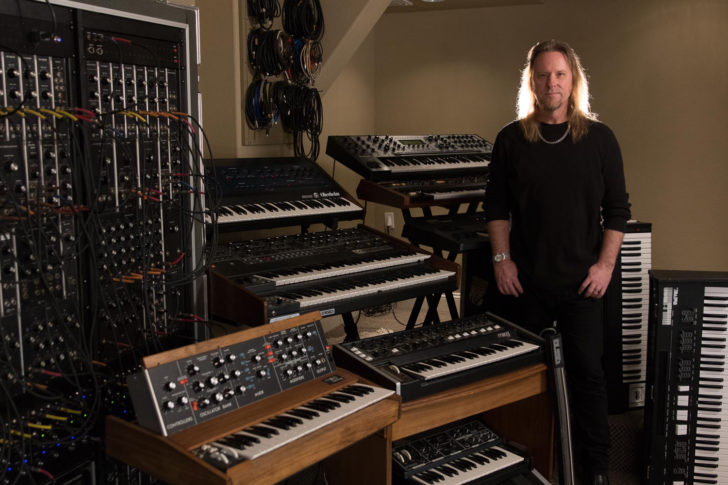Synthesist Erik Norlander, above, stays busy, keeping the prog flame alive with his solo and band projects; touring with rock supergroups, including Asia Featuring John Payne; performing on and producing dozens of albums; and doing design work on synths like the Alesis Andromeda.
His latest project is handling design work on IK Multimedia’s new UNO Synth, which was introduced at Superbooth 2018 and is now available.
We asked Norlander about the UNO, and how he and IK Multimedia went about designing the new synth.

Synthtopia: Since the UNO Synth was introduced at Superbooth, there’s been a lot of discussion about it, on Synthtopia and on other sites. For anybody that hasn’t heard about it yet, though, what’s your ‘elevator pitch’ introduction?
Erik Norlander: The UNO Synth is an affordable 2-oscillator real analog synthesizer, with a 2-pole multimode filter, 2 envelopes, LFO, arpeggiator, sequencer and 100 presets.
Did I mention it’s real analog? It’s real analog.
Synthtopia: What about your background and how you got into designing synthesizers? Your career has included recording and releasing dozens of albums, touring with rock and prog supergroups, music production and designing synths like the Andromeda. That’s a lot of territory.
What’s your ‘day job’ and how do you balance all these projects?
Erik Norlander: That’s actually the key to balancing these various projects: I don’t really have a day job!
I take every project super seriously, whether it’s designing a synthesizer, recording and editing a sound library, making an album or doing a tour with a rock band. I don’t over-commit, and I do my very best never to “phone in” any project.
It’s either do it 100% or don’t do it. All of these jobs are things I would do for free (and have done for free!), so it’s real privilege to have reached this point in my career.
But as you can imagine, being an active musician and designing products goes hand in hand. You know exactly what sounds work, exactly what features work, etc. when you are using the stuff every day in real life.
One example is our Syntronik product. You can imagine the huge amount of sample editing that was required for that. I did a lot of the editing while on a tour bus in Europe! I was doing this lengthy tour there, but of course all the actual gigs were at night.
So what do I do all day? Work on the sample library!
Why not? Often I even tried out sounds onstage when I needed to see what worked and what needed further refinement. How’s that for opportunity?
Synthtopia: Can you tell us a little bit about how you got into doing synth design work and some of the projects you’ve worked on before working with IK Multimedia?
Erik Norlander: I got into the synth design world in the early 90s, after licensing some samples to Alesis Studio Electronics for the original QuadraSynth. I think it was Rhodes, Hammond and some synth samples, if I remember correctly.
They liked my sounds, so after the product was released and not received so well, they asked me to come in and help with the re-voicing of it. That led to my first actual product, the QuadraSynth Plus, which was a major revamp of the instrument.
I became the first Synthesizer Product Manager for the company, and that let to the QS6, then the QS8 and other related products like the NanoPiano and other modules, including the DM5 and DM Pro drum products.

But, of course, the height of my career at Alesis was the Andromeda, a 16-voice 32-oscillator 32-filter real analog synthesizer (did I mention real analog?).
The Andromeda was made at a time when analog was not really done anymore. It was all about “virtual analog” then.
I convinced Keith Barr, the owner of Alesis and a genius chip designer, to design custom silicon ASICs (Application Specific Integrated Circuit) for the Andromeda, which he loved doing.
By the way, did you know about the secret pun in the product name?
The Andromeda also has the designation, “A6.” You would think that stands for “analog” and “6” for 61 keys. Yes, true, but if you say “A6” in English, it sounds exactly like “ASICs,” the chips that make the actual sound of the synth.
Our marketing guru, David Bryce, came up with the name “Andromeda,” but I insisted on keeping the A6 for that reason. My sense of humor, I suppose!
Oh, and I was even able to get Bob Moog to consult and help us!
I used to get these faxes from Bob, and I would take them to Keith and the engineering team like bringing down The Ten Commandments from the mountain. “Hey, check it out, Bob Moog said to try THIS!”
Then after Alesis, I did some independent work for Yamaha, Dave Smith Instruments, Waldorf, Midiman / Avid, MOTU and other companies. All the while recording albums and touring as a musician.
See the lines on my face? Now you know what put them there!
Synthtopia: Some readers may not realize that you’ve been working with IK Multimedia for quite a while. Can you tell us how that came about, and some of the projects you’ve worked on with them?
Erik Norlander: I met Enrico Iori, the owner and main designer of IK in 2010 through Dave Kerzner, who owns the Sonic Reality sound design company. I’ve known Dave for over 20 years since he was going to music school in Los Angeles with a bandmate of mine.
Dave went on to provide some sample content for me at Alesis which we used on several of the “Q Cards,” expansion libraries for the QS series synths. I returned the favor in the mid 2000s when I licensed samples for the SampleMoog virtual instrument to Dave.
So I already had a connection to IK from that, but I didn’t know any of the other IK guys directly. Dave’s brother, Gary, runs IK in the US and is a major force in the company. They actually asked me to do some writing for the company, both technical and marketing, so I started helping them with that, believe it or not.
Then I got involved in the SampleTank 3 project and recorded a lot of content for that, particularly the Ethnic and Percussion category sounds which I recorded with my drummer friends, Greg Ellis and Gregg Bissonette. Greg Ellis and I then went on to record the Cinematic Percussion and Orchestral Percussion instrument collections (sound libraries) for SampleTank 3. I also recorded some of the content for Miroslav Philarharmonik 2, like the mallet instruments.
From there we created Syntronik, a synth virtual instrument based on my rather extensive synthesizer collection. I provided the samples — which I had recorded over a period of about 20 years! — and IK provided the brilliant modeling technology for the filters and effects.
We continue to add to it. As you know from Superbooth in Berlin, earlier this year we released 5 more synths for Syntronik, including the ones based on the EMS VCS3 and Memorymoog. I plan to add more there, naturally. I really love that product!

Designing The UNO Synthesizer
Synthtopia: So your latest project is the UNO, which has already generated a lot of interest and a lot of questions from readers. Before we get into reader questions, though, tell us how the idea for the UNO came about.
Erik Norlander: Enrico, the owner of IK, of course knew my background with synths, and he and I had talked about making a hardware synth product for some time. Then through serendipity, Davide Mancini and Sound Machines approached IK in Italy, to see if they would like to collaborate on a product.
It was the perfect storm. Enrico and I designed the UNO Synth — after about a thousand iterations! — and Sound Machines executed the design in hardware. The IK CTO, Davide Barbi, was instrumental in the process as well. He is a super talented electrical engineer, among other things, so he was great at problem solving and identifying various issues.
Synthtopia: What was the original concept or design spec that you started with?
Erik Norlander: IK has done very well in the mobile world, starting with the iRig guitar interface and of course continue with things like the iLoud series of powered speakers. So we wanted to enter the hardware synth market with something that would fit with that kind of a product line, a super portable synthesizer.
We wanted it to be affordable, too, as that usually goes hand-in-hand with the mobile market. Oh, and it had to sound amazing, so real analog was the clear pathway to that.
The idea was to create “the analog synth for everyone.” And that’s what we did in the end.
Synthtopia: How do you go from an idea like that to having a prototype that you can demo at Superbooth? We talked at Superbooth about it being a team process with IK and Soundmachines. What’s that process like and who does what?
Erik Norlander: We started with just breadboard prototypes of the circuit. Sound Machines would send us audio and even video examples of the various sections, and we would evaluate those.
Then with 3D printing, it was possible make physical prototypes of the units to test the functionality of the capacitance sensing technology and do a real proof-of-concept with the user interface.
With every step, of course there were things that needed to be refined, some in hardware, some in the firmware. The firmware in particular tends to be an ongoing process.
Synthtopia: Here are a few questions we’ve seen popping up from readers.

Some readers look at the UNO and it reminds them of the membrane switch synth interfaces of the 80’s, which were a weak spot on some of those synths.
Can you clarify the difference between a membrane interface, and the capacitive sensing panel of the UNO?
Erik Norlander: Yes, that is naturally what you think of when you first see the UNO Synth.
Happily, what we are doing is completely different from the old membrane switches on things like the DX7, Moog Source or ARP Chroma. Those are physical switches with a plastic overlay. So as you continue to press the buttons, the switches start to wear away at the plastic and eventually poke through. You see so many old DX7s that have holes in the overlay now.
The UNO Synth uses capacitance sensing technology for the buttons. There are no physical switches on the synth, aside from the power switch on the back. It has more in common with the old Buchla capacitance sensing keyboards and controllers, where the surface detects the capacitance of your finger. It works very similar to a smartphone that way.
So you actually don’t have to “press” anything on the UNO Synth. You just touch it, glide over the surface. It’s very elegant and artistic when you get used to it. I’ve seen a lot of people come up to the synth and start truly banging on it like it’s an MPC drum machine. But you don’t need to do that — a light touch works just as well.
Synthtopia: A lot of readers are wondering about what’s analog and what’s digital on the UNO. And how do you decide which elements of the synth you want to make analog or digital?
Erik Norlander: That’s a good question, and happily the answer is super clear and easy. The audio path is analog, and the control path is digital.
So the oscillators, noise generator and filter — all the things that actually make the sound and color the sound — are analog. Then the things that modulate the sound — the LFO, the envelopes, the CV control of pitch, etc. — are digital.
This is what we did on the Andromeda, of course. It’s a great way to get the best of both worlds. You get real analog sound, that infinite, constantly changing beautiful tone that we all love so much, along with precise digital control.
The digital also allows us to actually add features after the hardware is built. Because the oscillator and filter frequencies just get a final coefficient as a control, we can generate that control almost any way we want. For example, It could be via a 2-stage envelope, a 4-stage envelope, a simple ramp or even something completely wild and esoteric beyond the typical controls.
Synthtopia: Readers are interested in whether the oscillators are VCOs or DCO’s, if the noise source is analog etc.
Erik Norlander: They are real VCOs, not DCOs. And the noise source is analog.

UNO Synth FAQs
Synthtopia: We also saw a lot of reader questions that can probably can be addressed with short FAQ answers.
Can you chain patterns on this or is it 16 step patterns only?
Erik Norlander: You cannot chain patterns, but since every preset has a pattern associated with it, you can change presets, the UNO Synth will wait for the next bar line to actually change. So you can go from pattern to pattern this way without any hiccups or odd bars.
Synthtopia: Can you sequence parameter changes? Can you record motion sequencing?
Erik Norlander: Yes you can. You can record 20 synth parameters for each of the 16 steps. This lets you completely transform the sound from step to step.
And because of the analog circuit design, the changes are smooth with no zippering, even when they happen super fast.
Synthtopia: Is MIDI control limited to 128 steps?
Erik Norlander: Yes.
Synthtopia: Can it be used as a MIDI keyboard controller via USB?
Erik Norlander: Yes it can, and it is also a USB MIDI interface, since we have both USB MIDI and the 2.5mm to DIN connector jacks for the traditional 5-pin MIDI connection.
So if you want to connect your computer to your old DX7 with the broken membrane switches, you can use the UNO Synth as the MIDI interface.
Synthtopia: How can the Line In be used?
Erik Norlander: It is simply a pass-through connection for daisy chaining another UNO Synth, a drum machine or other audio signals. The audio in does not go through the filter.
Synthtopia: Can the digital effects be bypassed entirely to get straight analog audio?
Erik Norlander: Yes, the delay is just added to the analog output, not mixed or balanced with it.
So if you don’t want to hear the digital delay, set the Mix control to zero and you have nothing but beautiful analog synth tone.
Synthtopia: Is there an option to store presets under the pads, or something like that, to get quick access to sounds for performance?
Erik Norlander: Not yet.
Synthtopia: Does the filter self-oscillate?
Erik Norlander: It does not, and this was by design. There is this strange fascination with turning a filter into a sine wave oscillator, and I know a lot of people find that interesting. It would be easy enough to do on the UNO Synth — we would just let the resonance control go farther. But we made the decision to limit the resonance for the sake of clarity and simplicity.
If we let the filter self-oscillate, then many less experienced users might get stuck wondering why the oscillator controls no longer worked, or if filter keyboard tracking was turned off, why the keyboard no longer played notes.
But if you really want the sound of that self-oscillating sine wave, okay, just set one of the oscillators to the triangle wave and turn down the filter cutoff. Et voilà!
Synthtopia: What additional options do you get access to by using a computer for editing?
Erik Norlander: You can also use an iPhone or iPad with the UNO Synth Editor.
You can adjust the oscillator shape modulation or pulse width modulation, the sweep of the pulse width or oscillator shape controlled by the filter envelope, the speed of the scoop and dive controls, the depth of the vibrato, wah and trem controls, turn keyboard tracking on and off, set global functions like the MIDI soft through or knob editing mode (Absolute, Relative, Pass-Through) … lots of cool things like that.
You can also do these things with MIDI CCs and SysEx, but it sure is a lot faster with the editor.
Another cool thing about the UNO Synth Editor is that when you use it as a plug-in within a DAW session, it will store the current state of the synth in the DAW session, just like a virtual instrument plug-in. So no need to actually save the preset for the song in the synth itself, if you don’t want to.
Synthtopia: Erik – thanks for taking the time to share some background on the creation of the UNO – and to answer some reader questions, too.
Erik Norlander: Thanks as always, Synthtopia — we love you guys!
You can find out more about the UNO and Erik Norlander’s work at IK Multimedia via the Superbooth 2018 videos embedded below. Details and demos for the UNO Synth are available at the IK Multimedia site. And see Norlander’s site for more about him and his music.


Good stuff, nice interview.
good work, i was honestly kinda non excited by this synth until i saw this
Was feeling bad for being kind of harsh early on, but after reading this I am not.
Synthtopia: Does the filter self-oscillate?
Erik Norlander: It does not, and this was by design. There is this strange fascination with turning a filter into a sine wave oscillator, and I know a lot of people find that interesting. It would be easy enough to do on the UNO Synth — we would just let the resonance control go farther. But we made the decision to limit the resonance for the sake of clarity and simplicity.
If we let the filter self-oscillate, then many less experienced users might get stuck wondering why the oscillator controls no longer worked, or if filter keyboard tracking was turned off, why the keyboard no longer played notes.
But if you really want the sound of that self-oscillating sine wave, okay, just set one of the oscillators to the triangle wave and turn down the filter cutoff. Et voilà!
Takes away a feature simply because someone inexperienced may get confused by it. That is what trial and error is for, to grow and to learn….not cool to play dad and protect us from ourselves. It’s not even a deal breaking feature removed….but the reason behind it turns me off.
It will be a fun device for the right people, just not me.
Bring on the hate comments, I speak from the heart.
I don’t think they’re ‘taking away feature’ as much as deciding that self-resonance is not an important feature for this synth.
It’s not a feature of LOTS of filter designs, because it has limited usefulness.
It is not a feature I care about. It’s just the reason he gave for removing it kind of turns me off. One day I will probobaly test out the synth when I can get it used under $100. All affordable analog VCO synths deserve a test drive.
In general, the most loved synths of all time are ones where the designer limited them severely to make them easier to use and to make it harder to make ‘bad sounds’.
The Minimoog is an obvious example – it’s a synth with training wheels, but everything it can do is musical.
Not saying that the UNO is in that league, but making a great synth depends on the designer are saying “no” to a lot of things, otherwise you end up with menu hell or the $25,000 Schmidt.
The Schmidt is definitely one of my ultimate goals. I don’t have a problem with menu diving but I prefer knob/fader/button per function. The DX range of synths don’t bother me when programming as they do most people.
Sounds like we’d probably agree on a lot of things.
The Schmidt is gorgeous and I can appreciate the design, but I don’t have any fantasy about owning a $25,000 synth, even if I had the money. I’d be afraid my cat would pee on it!
I’m ok with the compromises of the DX line, too – because Yamaha essentially committed to making a great, expressive preset synth, but also made it possible for hardcore people to dig deeper.
Two extremes, but the designers knew what they wanted to make and committed to it.
I’ve even warmed up to the BEHRINGER D. It’s a cheap knockoff, but it’s an obsessive compulsive cheap knockoff.
What I don’t like is when companies can’t commit to what they’re doing and make the decisions to do it right.
Like the JD-Xi – it could have been a great minisynth, but instead it’s a V8 synth engine in a Yugo body.
There’s way too many synths made to be cheap, vs designed to be a great budget synth. I think the UNO is one of the latter.
I agree that’s a dumb reason. And the filter tracking?? Kid gloves!! It makes him sound pretty out of touch. Self reonance is also really cool for wacky, liquidy filter modulations, and jumping in and out of self resonance while tweaking.
> Takes away a feature simply because someone inexperienced may get confused by it.
making limitations and thus taking away features is the main principle of creating instruments.
You were harsh on the previous post about the sound, and there were many replies and other comments in the thread from those that did like the sound quite a bit Of course your opinion there and here is valid – at least this time you didn’t directly recommend another manufacturer’s gear at the end of your comment or I’d start wondering…
Note that Erik mentions how to achieve the same sound quite easily (and it is there in your quote) so I’m not sure I see the full issue here.
About 10 years ago, maybe more, I saw a heated, condescending response from IK to a user (not me) about some issue. I think it was back on the old KVR boards. While the issue is forgotten, the condescending, snarky responses from the IK rep immediately turned me off to your company, and I have ignored your products ever since.
I started paying attention again when this synth was announced. I thought, “Surely that person is long gone and the company has figured out how to behave online.”
Boy, how wrong I was. Just with this one defensive post, you still come acrsss as insecure and belittling.
Sorry IK. I, for one, can’t support you. Not that you care.
Hi, I have not been here 10 years but either way I am sorry to hear that my reply was interpreted in this way as that was not my intention. Please note that while tone is impossible to fully relay via only text, I did try to use an emoticon to clarify the jovial tone of the comment.
Also, I think the comment hierarchy is messed up a bit and it doesn’t appear that my reply is actually replying to the correct comment. That may explain some, too
No. I think your comment aligned correctly.
Phrases like “I’m not sure I see the full issue here,” comes across as condescending. “You were harsh, but others said it sounded great” (paraphrasing) is defensive.
I can’t believe the bitter tone of one particular company can linger so long, but for whatever reason, it has.
Just keep doing your thing. Obviously most people don’t care. There are some companies that do the online thing REALLY damn well, but far be it for me to mention any of them lest you think I’m a shill. (Another defensive tactic you used in your response.)
But you could learn from them.
Its an amazing little synth for that price. Check out the demos on soundcloud! Really like the frequent answer Erik Norlander gives in this interview: “Yes it can (do that)”.
Very interesting interview – Erik has a sense of humour doesn’t he!
I wonder how many they will shift at £200 a go…..at least synths are getting more affordable now……it sets the bar
Met Erik at Superbooth this year. Great guy. Oddly enough, although I have a couple of his CDs, I didn’t recognize him until he told me his full name. Though I knew he had worked on the A6, I wasn’t aware of the rest of his product development and sound work. Now if he could only convince Alesis to get back into making real synths. : )
Good interview and thanks.
If only the Andromeda had been manufactured by a decent company I would still have one. Shame as the design and sounds are awesome.
What was the problem with yours?
Build quality – the keyboard double triggered notes because key returns were not damped properly so the keys bounced. Alesis didnt want to know, so they got a month old synth returned to them and lost a customer for life. I know build quality was a problem with a lot of Andromedas, if Korg, Roland or Yamaha, or DSI had built the synth it would have been properly put together. Shame as it is an awesome instrument.
Norlander seems like an interesting guy – what a cool variety of stuff he’s worked on!
I hope that the UNO does well enough for him to get another shot at designing a polyphonic synth. The Andromeda was before it’s time.
Also – the UNO makes the Volcas look a little past their shelf date, doesn’t it? Kind of amazing how quickly the low end of the synth market is evolving!
Yes it will be interesting to see how Korg might respond to this move.
I think Korg should bring out a new micro sampler.
I love the look of the Uno. The big block and square flat design. It looks very tweakable!
that light behind him gently illuminating his rock keyboardist mane is known as a “prog light”, in the tv biz we don’t use it much anymore but with that queen biopic coming out some are predicting a prog light revival.
I did some shopping in Paris yesterday, and bought this little beast. I’ve spent all the evening on it.
It’s a fantastic couch synth,
It’s tiny, light and elegant. The sound is definitely fat, gritty and huge. It won’t be to everybody’s taste, but there is a lot of personality inside this lightweight analog.
The GUI is brilliant, I love the little capacitor keyboard, which is surprisingly fun to play.
I just got mine this weekend – agree it is a great couch synth. I paired it up with a JX-03 and DX-200 too and man, you can get some great 80s sounds out of it.
Looking forward to the NEW FIRMWARE update that will soon allow users to control PWM/full ADSR from the front panel, rather than having to tether a PC editor or external MIDI CC controller to it.
Hey Guys!
If you have yet to get the new Firmware updater this can be found here: https://www.ikmultimedia.com/userarea/firmware/
This will add full ADSR control with the UNO Synth’s on-board controls. This will also make some optimizations tot he unit and allow for use with the Editor.
Press and hold FILTER to get to the ADSR for the Filter.
Press and hold ENVELOPE to get to the ADSR for Amplitude.
To see more on the UNO Synth Editor, as well as how each part of the UNO Synth works, check out the tutorial series below.
https://www.ikmultimedia.com/products/unosynth/index.php?pp=unosynth-tutorial